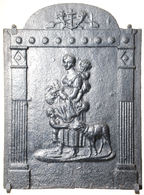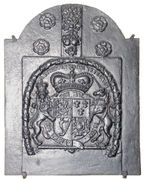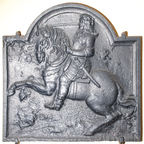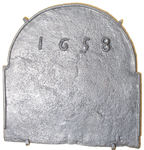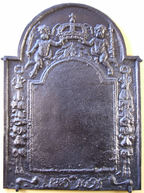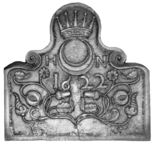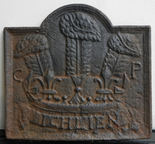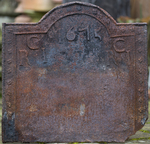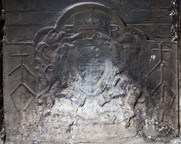-
533
Description: Arched rectangular shape; fluted pilasters supporting a lintel with nine evenly spaced flowers arranged horizontally; central standing female figure, holding a basket of flowers, a child upon her back, another child by her side, and a sheep to her left; on top, a symmetrical arrangement of an anchor, two paddles and two cornucopiae.
Notes: The figure would seem to represent Charity. One of a series with a distinctly Empire style. Mitford collection, Petworth House.
- Decoration tags:
- rectangular with round arch (shape)
- none (edging)
- whole carved pattern
- pictorial
- allegorical
- animals
- humans
Manufactured: in the late-18th to early-19th century in France.
Current location: Petworth House, Petworth, West Sussex, England.
Museum number: NT/PET/M/86 (part of the National Trust museum group)
Citation: Carpentier, H., 1912, Plaques de Cheminées (Paris, published by the author).
- Attached to series:
- Miscellaneous pattern firebacks
-
535
Description: Arched rectangular shape; no edging; raised central square surmounted by Royal Arms of Great Britain and Ireland, with Garter, crown and lion and unicorn supporters; surrounded by a horseshoe-shaped, twisted floral wreath, within which the inscription is printed in capitals. Above the arms a raised rectangular fillet is surmounted by two suspended floral swags, one above the other, comprising roses and oak apples. On each side of the fillet are two Tudor roses, one above the other.
Notes: Dated to between 1714 and 1801. The inscription is the visible part of an abbreviated version of the formal title of the monarch, ‘By the Grace of God, of Great Britain, France and Ireland, King, Defender of the Faith, Duke of Brunswick and Lünenburg, Arch Treasurer and Prince Elector of the Holy Roman Empire’. Mitford collection, Petworth House.
Copies of this fireback are known.
Inscription: MAG BRIT FRA ET HIB REX F D BRUN ET LUN DUX / HONY SOIT QUI MAL Y PENSE
Arms: English Hanoverian royal
- Decoration tags:
- rectangular with round arch (shape)
- none (edging)
- whole carved pattern
- armorial
- royal
- text
- plants
Manufactured: in the 18th century in England.
Current location: Petworth House, Petworth, West Sussex, England.
Museum number: NT/PET/M/89 (part of the National Trust museum group)
- Attached to series:
- Hanoverian royal armorial firebacks
-
523
Description: Arched rectangular shape; cavetto-moulded edging; figure in mid-17th century armour, sword in belt, riding a prancing horse; initials split, below corners of arch, in front of horse’s head and behind rider’s back.
Notes: Probably intended to represent Charles I in memoriam, as other firebacks in this style date from the end of the Commonwealth period. Mitford collection, Petworth House.
Copies of this fireback are known.
Inscription: [C missing] R
- Decoration tags:
- rectangular with round arch (shape)
- cavetto (edging)
- whole carved pattern
- pictorial
- text
- animals
- humans
Manufactured: in the mid-17th century in the Weald area of England.
Current location: Petworth House, Petworth, West Sussex, England.
Museum number: NT/PET/M/77 (part of the National Trust museum group)
Citation: Baines, J. M., 1958, Wealden Firebacks (Hastings Museum).
Citation: Lloyd, N., 1925, 'Domestic Ironwork I', Architectural Review, 58, pp. 58-67.
- Attached to series:
- Small cavetto series
-
532
Description: Arched rectangular shaped with narrow shoulders; fillet edging; date in individual numerals across arch.
Notes: A smaller version is different in the spacing of the numerals and the proportions of the plate. Mitford collection, Petworth House.
Inscription: 1658
- Decoration tags:
- rectangular with round arch (shape)
- rope (edging)
- carved stamps
- individual numbers
- text
Manufactured: in 1658 possibly in the Weald area of England.
Current location: Petworth House, Petworth, West Sussex, England.
Museum number: NT/PET/M/85 (part of the National Trust museum group)
- Attached to series:
- 1658 arched series
- Date only firebacks
-
538
Description: Arched rectangular shape; fillet edging; blank arched rectangular central panel with rebated fillet edging; on top, above a cone of laurel leaves, a crown supported by two putti, each holding a plant stem; on each side, a flower and fruit festoon suspended on a ribbon from a ring; at the bottom , inscription on a scroll.
Notes: A border panel, usually incorporated with a separate pictorial central panel. Mitford collection, Petworth House.
Copies of this fireback are known.
Inscription: [...]O 1695
- Decoration tags:
- rectangular with round arch (shape)
- fillet (edging)
- carved pattern panels
- text
- humans
- plants
- objects
Manufactured: in 1695 in the Siegerland area of Germany.
Current location: Petworth House, Petworth, Kent, England.
Museum number: NT/PET/M/93 (part of the National Trust museum group)
- Attached to series:
- 'Dutch' Border only firebacks
- 'Dutch' 1695 Crown series
-
584
Description: Of unique design; quasi-arched rectangular shape; ribbon border, curled on each side of the neck. Symmetrical arrangement of plant tendrils with acorns, oak leaves, pomegranates and other leaves across the rectangular base; above and centrally placed are the date, over which are the initials either side of a crescent moon, surmounted by an earl’s coronet.
Notes: The initials, H N, are thought to refer to Henry, 9th Earl of Northumberland, and the date to his release from the Tower of London following his 17 years’ imprisonment for alleged involvement in the Gunpowder Plot.
Copies of this fireback are known.
Inscription: H N / 1622
- Decoration tags:
- rectangular with round arch (shape)
- complex individual (edging)
- whole carved pattern
- heraldic
- text
- plants
Manufactured: in 1622 probably at Frith Furnace, Northchapel in the Weald area of England.
Current location: Petworth House, Petworth, West Sussex, England.
Museum number: 485698 (part of the National Trust museum group)
- Attached to series:
- Personal firebacks
- Petworth lettering series
-
198
Description: Arched rectangular shape; cavetto-moulded edging; English royal coronet with three ostrich feathers rising from within; below, a motto scroll with inscription.
Notes: The badge of the Prince of Wales; the initials, CP, are probably for Carolus Princep; the motto is mis-spelled in error for 'Ich Dien' - I serve, which is more likely a mistranscription rather than a deliberate slur. The apparent crack in the angle of the arch and the top left of the fireback is an impression, indicating that this is a recasting.
Copies of this fireback are known.
Inscription: C P/ICH LIEN
- Decoration tags:
- rectangular with round arch (shape)
- cavetto (edging)
- whole carved pattern
- heraldic
- royal
- text
Manufactured: in the mid-17th century possibly in the Weald area of England.
Current location: not known.
- Attached to series:
- Prince of Wales firebacks
-
978
Description: Arched rectangular shape; twisted rope edging with inaccurately parallel arched rectangular fillet inside, enclosing repeated small fleur-de-lys stamps along sides and top; initials in triad in each of the internal top corners; date in arch.
Notes: The initials probably relate to a couple whose surname begins with C, the husband's forename initial being R and the wife's I (or J).
Inscription: RCI/ 1675 / RCI
- Decoration tags:
- rectangular with round arch (shape)
- rope (edging)
- simple stamps
- carved stamps
- individual letters
- individual numbers
- heraldic
- text
Manufactured: in 1675 in England.
Current location: not known.
- Attached to series:
- Date & initials firebacks
-
1248
Description: Central arched rectangular shape with rounded corners; ovolo moulding all round; oval Tudor royal shield with garter surrounding, topped with a royal crown; dragon and greyhound supporters; initials split by crown; all details below shield illegible; rectangular extension panels on each side, with twisted rope edging; quasi mirrored arrangement of twisted rope lengths to form (from the top) a cross, a vertical pointing arrow, and a diamond shape with a central vertical line.
Notes: The detail of the extension panel is sharper than the armorial, indicating that the panel was cast with a worn copy of the armorial. Illustrated in Weaver, 1914, p. 16.
Inscription: E R [+ Garter, Harvo and royal mottoes, all illegible]
Arms: Tudor royal (prob. Henry VIII)
- Decoration tags:
- rectangular with round arch (shape)
- rope and ovolo moulding (edging)
- simple stamps
- whole carved pattern
- extension panels
- heraldic
- apotropaic
- armorial
- royal
- text
- objects
Manufactured: in the late-16th to early-17th century in the Weald area of England.
Current location: in private hands, Plaistow, West Sussex, England.
Citation: Weaver, L., 1914, Small Country Houses: their repair and enlargement (London, Country Life).
- Attached to series:
- Pounsley series
- John Harvo series
- Tudor royal armorial firebacks
-
589
Description: Double arched rectangular shaped; ovolo edging; central clock dial with Roman numerals separated by stops, sunburst inside, single hand with fleur de lys pointer; teardrop weights suspended from each side; symmetrical tendrils above.
Notes: One of the ‘hooked 1’ series of firebacks - the number ‘1’ is just discernable bottom left; two versions exist of this fireback, the other having finials above the suspended weights.
Copies of this fireback are known.
Inscription: I · II · III · IIII · V · VI · VII · VIII · IX · X · XI · XII / 16...
- Decoration tags:
- rectangular with round arch (shape)
- ovolo (edging)
- whole carved pattern
- text
- objects
Manufactured: in the mid-17th century possibly at Brede Furnace in the Weald area of England.
Current location: Ham House, Richmond, Surrey, England.
Museum number: 1139737 (part of the National Trust museum group)
- Attached to series:
- Hooked '1' series
- Brede group
